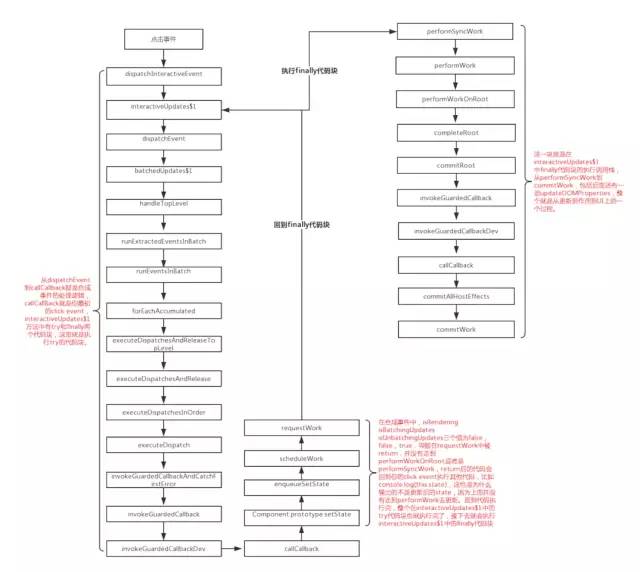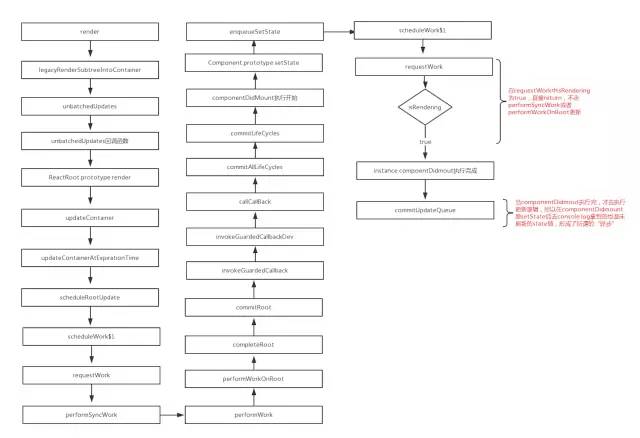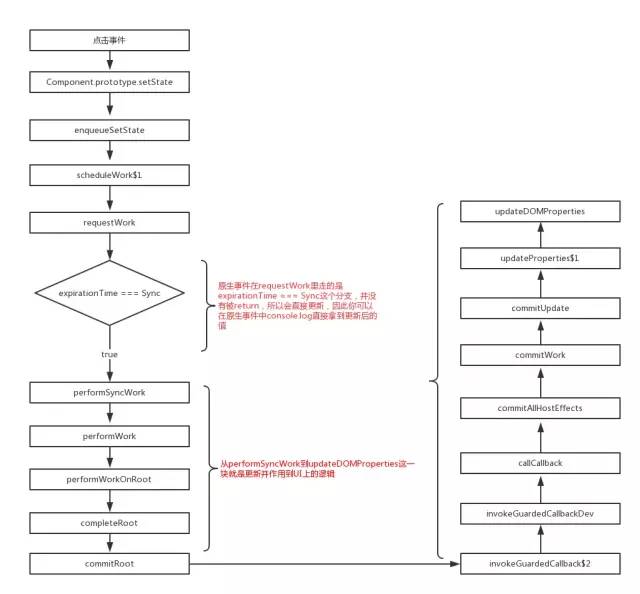你真的理解setState吗?
作者:虹晨,来源:https://juejin.im/post/5b45c57c51882519790c7441
setState真的是异步的吗?
这两天自己简单的看了下 setState 的部分实现代码,在这边给到大家一个自己个人的见解,可能文字或图片较多,没耐心的同学可以直接跳过看总结(源码版本是16.4.1)。
看之前,为了方便理解和简化流程,我们默认react内部代码执行到performWork 、performWorkOnRoot、performSyncWork、performAsyncWork这四个方法的时候,就是react去update更新并且作用到UI上。
一、合成事件中的setState
首先得了解一下什么是合成事件,react为了解决跨平台,兼容性问题,自己封装了一套事件机制,代理了原生的事件,像在jsx中常见的onClick、onChange这些都是合成事件。
class App extends Component {
state = { val: 0 }
increment = () => {
this.setState({ val: this.state.val + 1 })
console.log(this.state.val) // 输出的是更新前的val --> 0
}
render() {
return (
<div onClick={this.increment}>
{`Counter is: ${this.state.val}`}
</div>
)
}
}
合成事件中的setState写法比较常见,点击事件里去改变 this.state.val 的状态值,在 increment 事件中打个断点可以看到调用栈,这里我贴一张自己画的流程图:

从 dispatchInteractiveEvent 到 callCallBack 为止,都是对合成事件的处理和执行,从 setState 到 requestWork 是调用 this.setState 的逻辑,这边主要看下 requestWork 这个函数(从 dispatchEvent 到 requestWork 的调用栈是属于 interactiveUpdates$1 的 try 代码块,下文会提到)。
function requestWork(root, expirationTime) {
addRootToSchedule(root, expirationTime);
if (isRendering) {
// Prevent reentrancy. Remaining work will be scheduled at the end of
// the currently rendering batch.
return;
}
if (isBatchingUpdates) {
// Flush work at the end of the batch.
if (isUnbatchingUpdates) {
// ...unless we're inside unbatchedUpdates, in which case we should
// flush it now.
nextFlushedRoot = root;
nextFlushedExpirationTime = Sync;
performWorkOnRoot(root, Sync, false);
}
return;
}
// TODO: Get rid of Sync and use current time?
if (expirationTime === Sync) {
performSyncWork();
} else {
scheduleCallbackWithExpiration(expirationTime);
}
}
在 requestWork 中有三个if分支,三个分支中有两个方法 performWorkOnRoot 和 performSyncWork ,就是我们默认的update函数,但是在合成事件中,走的是第二个if分支,第二个分支中有两个标识 isBatchingUpdates 和 isUnbatchingUpdates 两个初始值都为 false ,但是在 interactiveUpdates$1 中会把 isBatchingUpdates 设为 true ,下面就是 interactiveUpdates$1 的代码:
function interactiveUpdates$1(fn, a, b) {
if (isBatchingInteractiveUpdates) {
return fn(a, b);
}
// If there are any pending interactive updates, synchronously flush them.
// This needs to happen before we read any handlers, because the effect of
// the previous event may influence which handlers are called during
// this event.
if (!isBatchingUpdates && !isRendering && lowestPendingInteractiveExpirationTime !== NoWork) {
// Synchronously flush pending interactive updates.
performWork(lowestPendingInteractiveExpirationTime, false, null);
lowestPendingInteractiveExpirationTime = NoWork;
}
var previousIsBatchingInteractiveUpdates = isBatchingInteractiveUpdates;
var previousIsBatchingUpdates = isBatchingUpdates;
isBatchingInteractiveUpdates = true;
isBatchingUpdates = true; // 把requestWork中的isBatchingUpdates标识改为true
try {
return fn(a, b);
} finally {
isBatchingInteractiveUpdates = previousIsBatchingInteractiveUpdates;
isBatchingUpdates = previousIsBatchingUpdates;
if (!isBatchingUpdates && !isRendering) {
performSyncWork();
}
}
}
在这个方法中把 isBatchingUpdates 设为了 true ,导致在 requestWork 方法中, isBatchingUpdates 为 true ,但是 isUnbatchingUpdates 是 false ,而被直接return了。
那return完的逻辑回到哪里呢,最终正是回到了 interactiveUpdates 这个方法,仔细看一眼,这个方法里面有个try finally语法,前端同学这个其实是用的比较少的,简单的说就是会先执行 try 代码块中的语句,然后再执行 finally 中的代码,而 fn(a, b) 是在try代码块中,刚才说到在 requestWork 中被return掉的也就是这个fn(上文提到的 从dispatchEvent 到 requestWork 的一整个调用栈)。
所以当你在 increment 中调用 setState 之后去console.log的时候,是属于 try 代码块中的执行,但是由于是合成事件,try代码块执行完state并没有更新,所以你输入的结果是更新前的 state 值,这就导致了所谓的"异步",但是当你的try代码块执行完的时候(也就是你的increment合成事件),这个时候会去执行 finally 里的代码,在 finally 中执行了 performSyncWork 方法,这个时候才会去更新你的 state 并且渲染到UI上。
二、生命周期函数中的setState
class App extends Component {
state = { val: 0 }
componentDidMount() {
this.setState({ val: this.state.val + 1 })
console.log(this.state.val) // 输出的还是更新前的值 --> 0
}
render() {
return (
<div>
{`Counter is: ${this.state.val}`}
</div>
)
}
}
钩子函数中setState的调用栈:

其实还是和合成事件一样,当 componentDidmount 执行的时候,react内部并没有更新,执行完componentDidmount 后才去 commitUpdateQueue 更新。这就导致你在 componentDidmount 中 setState 完去console.log拿的结果还是更新前的值。
三、原生事件中的setState
class App extends Component {
state = { val: 0 }
changeValue = () => {
this.setState({ val: this.state.val + 1 })
console.log(this.state.val) // 输出的是更新后的值 --> 1
}
componentDidMount() {
document.body.addEventListener('click', this.changeValue, false)
}
render() {
return (
<div>
{`Counter is: ${this.state.val}`}
</div>
)
}
}
原生事件是指非react合成事件,原生自带的事件监听 addEventListener ,或者也可以用原生js、jq直接 document.querySelector().onclick 这种绑定事件的形式都属于原生事件。

原生事件的调用栈就比较简单了,因为没有走合成事件的那一大堆,直接触发click事件,到 requestWork ,在requestWork里由于 expirationTime === Sync 的原因,直接走了 performSyncWork 去更新,并不像合成事件或钩子函数中被return,所以当你在原生事件中setState后,能同步拿到更新后的state值。
四、setTimeout中的setState
class App extends Component {
state = { val: 0 }
componentDidMount() {
setTimeout(_ => {
this.setState({ val: this.state.val + 1 })
console.log(this.state.val) // 输出更新后的值 --> 1
}, 0)
}
render() {
return (
<div>
{`Counter is: ${this.state.val}`}
</div>
)
}
}
在 setTimeout 中去 setState 并不算是一个单独的场景,它是随着你外层去决定的,因为你可以在合成事件中 setTimeout ,可以在钩子函数中 setTimeout ,也可以在原生事件setTimeout,但是不管是哪个场景下,基于event loop的模型下, setTimeout 中里去 setState 总能拿到最新的state值。
举个栗子,比如之前的合成事件,由于你是 setTimeout(_ => { this.setState()}, 0) 是在 try 代码块中,当你 try 代码块执行到 setTimeout 的时候,把它丢到列队里,并没有去执行,而是先执行的 finally 代码块,等 finally 执行完了, isBatchingUpdates 又变为了 false ,导致最后去执行队列里的 setState 时候, requestWork 走的是和原生事件一样的 expirationTime === Sync if分支,所以表现就会和原生事件一样,可以同步拿到最新的state值。
五、setState中的批量更新
class App extends Component {
state = { val: 0 }
batchUpdates = () => {
this.setState({ val: this.state.val + 1 })
this.setState({ val: this.state.val + 1 })
this.setState({ val: this.state.val + 1 })
}
render() {
return (
<div onClick={this.batchUpdates}>
{`Counter is ${this.state.val}`} // 1
</div>
)
}
}
上面的结果最终是1,在 setState 的时候react内部会创建一个 updateQueue ,通过 firstUpdate 、 lastUpdate 、 lastUpdate.next 去维护一个更新的队列,在最终的 performWork 中,相同的key会被覆盖,只会对最后一次的 setState 进行更新,下面是部分实现代码:
function createUpdateQueue(baseState) {
var queue = {
expirationTime: NoWork,
baseState: baseState,
firstUpdate: null,
lastUpdate: null,
firstCapturedUpdate: null,
lastCapturedUpdate: null,
firstEffect: null,
lastEffect: null,
firstCapturedEffect: null,
lastCapturedEffect: null
};
return queue;
}
function appendUpdateToQueue(queue, update, expirationTime) {
// Append the update to the end of the list.
if (queue.lastUpdate === null) {
// Queue is empty
queue.firstUpdate = queue.lastUpdate = update;
} else {
queue.lastUpdate.next = update;
queue.lastUpdate = update;
}
if (queue.expirationTime === NoWork || queue.expirationTime > expirationTime) {
// The incoming update has the earliest expiration of any update in the
// queue. Update the queue's expiration time.
queue.expirationTime = expirationTime;
}
}
看个?
class App extends React.Component {
state = { val: 0 }
componentDidMount() {
this.setState({ val: this.state.val + 1 })
console.log(this.state.val)
this.setState({ val: this.state.val + 1 })
console.log(this.state.val)
setTimeout(_ => {
this.setState({ val: this.state.val + 1 })
console.log(this.state.val);
this.setState({ val: this.state.val + 1 })
console.log(this.state.val)
}, 0)
}
render() {
return <div>{this.state.val}</div>
}
}
结合上面分析的,钩子函数中的 setState 无法立马拿到更新后的值,所以前两次都是输出0,当执行到 setTimeout 里的时候,前面两个state的值已经被更新,由于 setState 批量更新的策略, this.state.val 只对最后一次的生效,为1,而在 setTimmout 中 setState 是可以同步拿到更新结果,所以 setTimeout 中的两次输出2,3,最终结果就为 0, 0, 2, 3 。
总结 :
setState 只在合成事件和钩子函数中是“异步”的,在原生事件和 setTimeout 中都是同步的。
setState的“异步”并不是说内部由异步代码实现,其实本身执行的过程和代码都是同步的,只是合成事件和钩子函数的调用顺序在更新之前,导致在合成事件和钩子函数中没法立马拿到更新后的值,形式了所谓的“异步”,当然可以通过第二个参数 setState(partialState, callback) 中的callback拿到更新后的结果。
如果对同一个值进行多次 setState , setState 的批量更新策略会对其进行覆盖,取最后一次的执行,如果是同时 setState 多个不同的值,在更新时会对其进行合并批量更新。
以上就是我看了部分代码后的粗浅理解,对源码细节的那块分析的较少,主要是想让大家理解setState在不同的场景,不同的写法下到底发生了什么样的一个过程和结果,希望对大家有帮助,由于是个人的理解和见解,如果哪里有说的不对的地方,欢迎大家一起指出并讨论。
❤️爱心三连击 1.看到这里了就点个在看支持下吧,你的「点赞,在看」是我创作的动力。
2.关注公众号
程序员成长指北,回复「1」加入高级前端交流群!「在这里有好多 前端 开发者,会讨论 前端 Node 知识,互相学习」!3.也可添加微信【ikoala520】,一起成长。
“在看转发”是最大的支持
